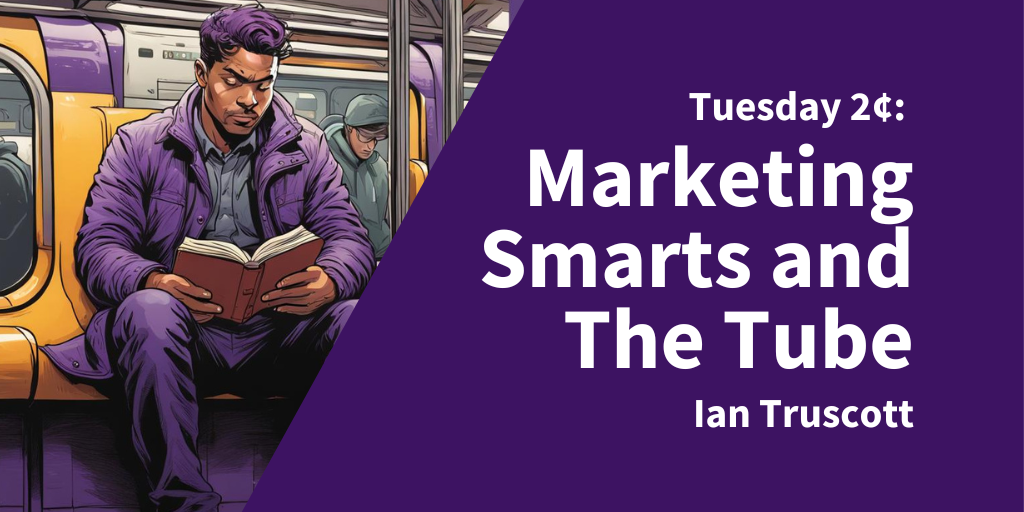This Tuesday, I’m pondering marketing education, inspired by a broken-down train on the London Underground…..
There is a fair amount of discussion about marketing education. Is it better to hire folks with a formal marketing education or if it’s a craft that benefits from being self-taught and experienced?
There is an argument that experience beats education, as it’s such a dynamic discipline that formal education can’t keep up. Others suggest the fundamentals don’t change; we’d get to value quicker if we trusted the trained people who know these fundamentals and amateurs stumbling around ruin the reputation of the profession.
No, that bright, hot thing you are evangelising about is not new. It’s not “agile heat and radical light”, it’s called fire, and the cave people of marketing discovered it some time ago.
Plus, of course, if there were a formal gateway to entry, like the legal bar exam or whatever certificate accountants need in your country to practice, we might be spared the opinion of just about everyone in the business about marketing that the legal department or the CFO don’t need to deal with.
Of course, the truth is that marketing is damn sexy and who does not want to talk about it? Way better to be in the lunchroom with the designs of the website than an EBITDA spreadsheet 🙂
Anyway, I was inspired to think about this as I observed people travelling around London today and recalled my own London commuter experience. Specifically, what happens when it goes wrong, like an experience I had today with a broken-down underground train.
The London Underground map is a beautiful stylised thing, but it can be a bit misleading regarding the stations’ proximity as on the map, the stations can look an equal distance apart, but geographically this varies.
A classic example is the little cluster of Leicester Square. Piccadilly Circus and Covent Garden, travelling between them on ‘the Tube’ is fairly pointless, by the time you’ve descended into the stations, navigated the ticket machines and waited for a train as they are a short joy of a walk from one another.
Regular London travellers not only know the map and intuitively the best way to get from A to B by tube on a good day, but they also know what to do when it goes wrong as the Tube offers multiple options, maybe taking a route that on the map doesn’t look obvious, or (as I did when the Tube failed me) rising to the surface and walking.
A studious knowledge of the tube map alone does not make a great London traveller, and this is a skill not academically learned; the London commuter just knows. However, the trap could be that they just know their route and their part of town. From Waterloo to Liverpool St and all points between, they are a commuting Ninja, but ask them to get to Mornington Crescent, which might as well be on the dark side of the moon.
To continue this travelling London analogy, if you rise to the surface, jump in a cab, and if it’s a black cab, you are in the hands of a professional who’s passed “the knowledge,” a three or four-year course that started in 1865 and requires your driver to know the London streets like the proverbial “back of their hand”. They don’t just know their part of London, they know all the major destinations and all the points between.
And, if you’d jumped into an Uber, the driver may be untrained on the streets of London, but now technology is your guide, with GPS and whatever the Uber algorithm overlays onto that map data.
My point with this convoluted analogy is that marketing knowledge, unlike law or accounting, is a mix of experience, creativity, formal education, the ability to leverage technology and a passion for lifelong learning.
Like the London landmarks, the fundamentals of marketing remain the same, but how we get there, well… it depends which trains are running.
Fancy more of this?
Subscribe to my Rockstar CMO Newsletter

I’m a 3xCMO, now a marketing strategy advisor and podcast host at Rockstar CMO. Although, I’m not a rock star, but a marketing leader, strategist, content marketer, columnist, speaker, industry watcher, and creator of ART (Awareness, Revenue, and Trust) for the companies I work with. But most of all, I am an enthusiastic tea drinker.
You can find me on LinkedIn, Twitter, or now Threads! – or listen to my weekly podcast at Rockstarcmo.com
The half-baked thoughts shared on this blog may not reflect those of my employer or clients, and if the topic of this article is interesting or you just want to say hello please get in touch.
